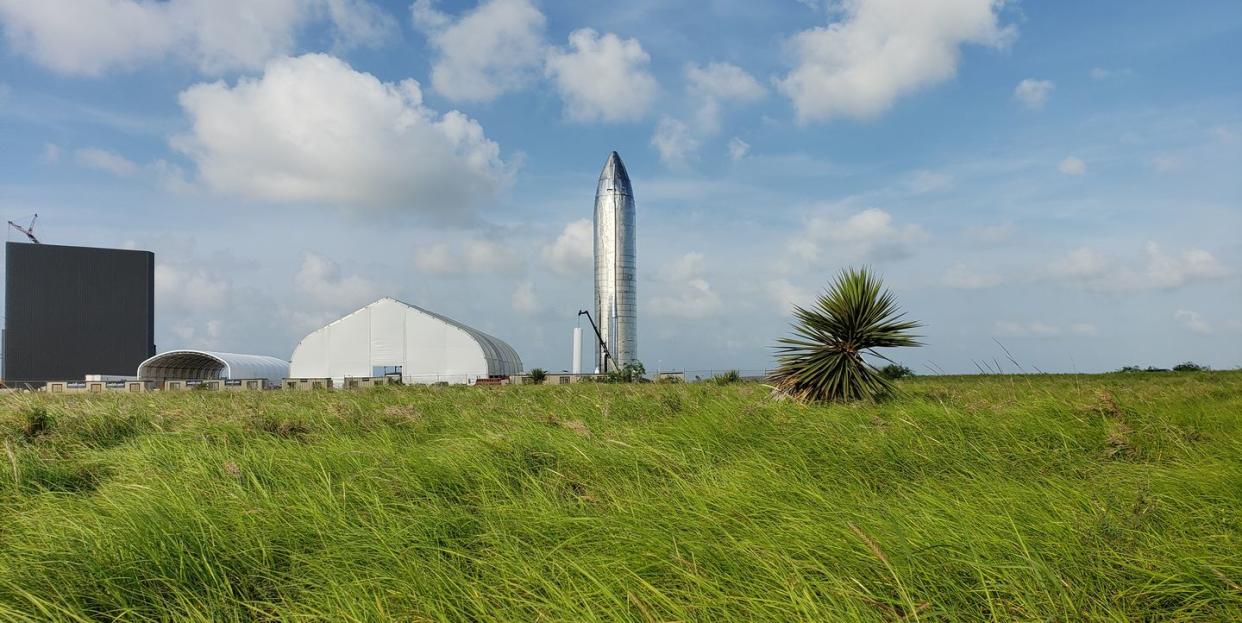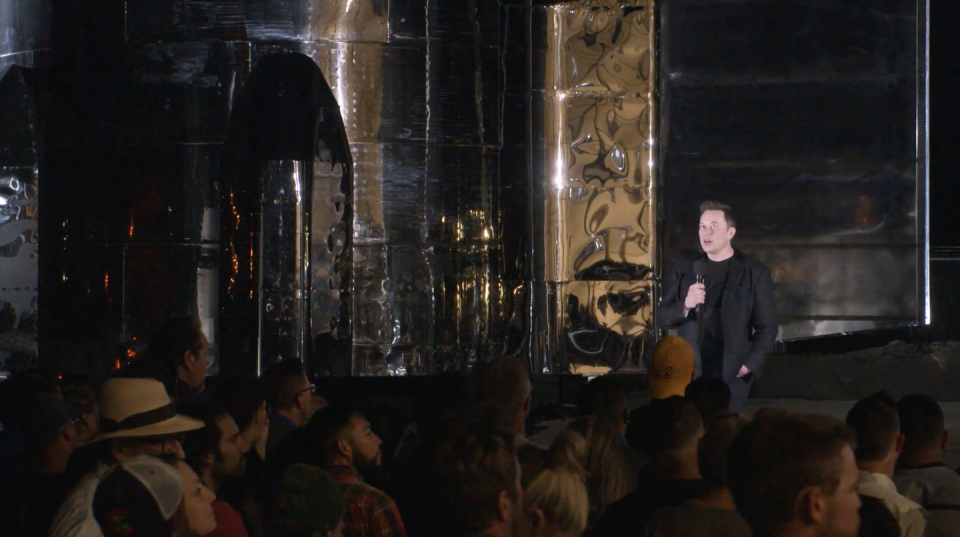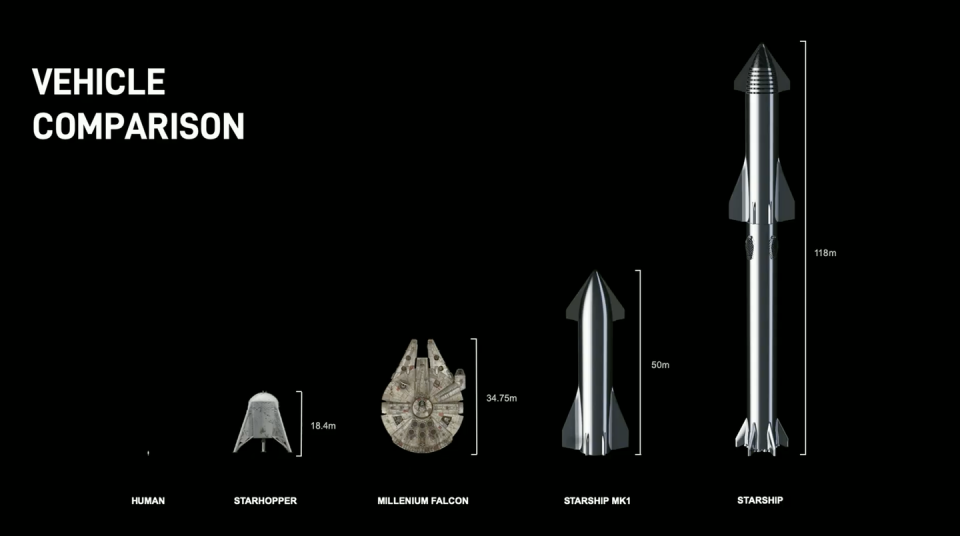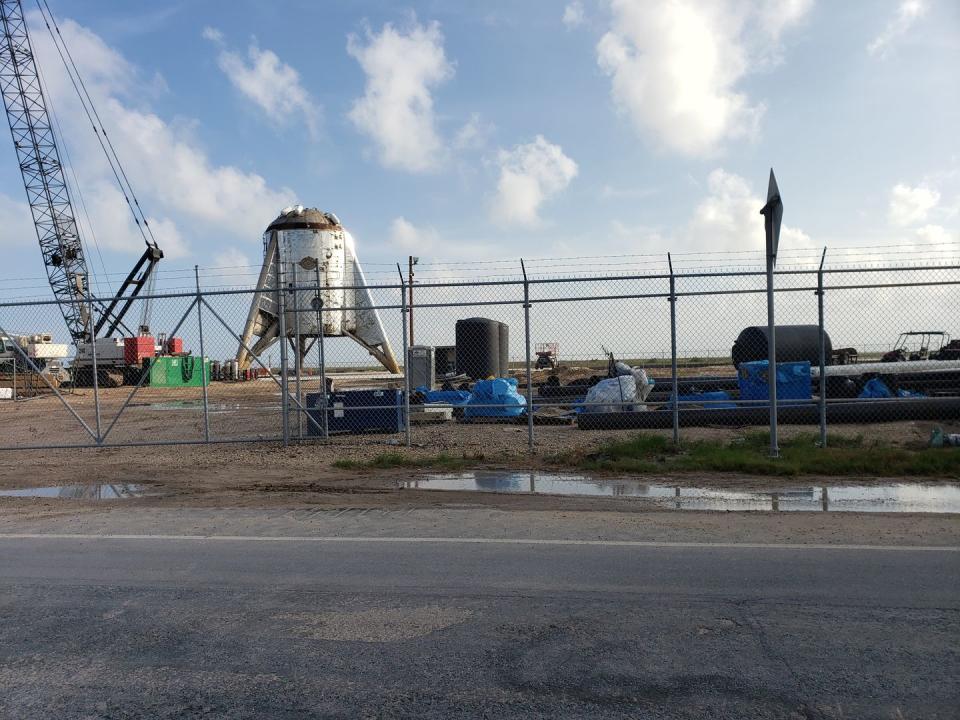Elon Musk Reveals SpaceX's New Starship, the Rocket Bound for Mars

Boca Chica Beach, Texas — The rocket ship stands gleaming in the South Texas sunset, the dark sky reflected off its aluminum skin. It’s called Starship Mark 1 and its owner, Elon Musk, is standing at its base to fill in the public on its progress.
"This is the most inspiring thing I’ve ever seen,” Musk told the crowd. “I’m so proud to work with such a great team.”
Laying Out the Dream

In what has become an annual event, the SpaceX founder and chief engineer gathered media together at SpaceX’s South Texas launch site to reveal the latest design for the spacecraft and rocket that the company hopes will one day visit the moon, Mars, and beyond. The final Starship version could hold as many as 100 passengers—a colony-sized manifest that speaks to the company’s ambition to settle humans off world. The spacecraft is called Starship, and its launch vehicle is Super Heavy.
MK 1 has not flown, but the vehicle already has the worn aspect of a prototype. Up close, the gleaming aluminum skin is textured with deformations and dents. Some of the seams appear like scars; Musk points out that the craft “was built outside instead of a factory."
The sunset reflection is marred by scuffs, abrasions, and dirt. This is no art project, the Mk 1 is built to work.

The 165-foot prototype standing behind Musk is destined for high-altitude testing, first reaching altitudes of 12 miles but eventually extending test flights of future versions into orbit, Musk says. A human being could fly on the Starship prototypes within a year, he adds.
The Starship will launch atop the company’s Super Heavy rocket, where Starship will become the largest upper stage ever built. The stainless-steel ship will have six Raptors, compared to this prototype’s three engines. Three will be for sea level and the rest for the vacuum of space. Meanwhile, the Super Heavy rocket will pack a hefty 35 Raptors.
The aluminum spacecraft holds the hopes of many on its metallic fins. If Musk has his way, this prototype could be a vital tool in creating one of the most historic vehicles ever made. Musk called the Starship and Super Heavy combination "the fastest path for a self-sustaining city on Mars."
MK 1 is the forerunner of the spaceship that may bring the first human visitors—possibly colonists—to Mars. SpaceX plans to use it to sell satellite launches in 2021 and one paying customer, Japanese billionaire Yusaku Maezawa, plans a Starship trip around the Moon in 2023. These high-flying aspirations seem a lot closer to reality here at Boca Chica Beach, where work over the years has alternated between a slow crawl and a breakneck pace.
Now there are prototypes flying on short hops and the roar of even more spacecraft engines—albeit without humans or a customer’s payload on board—is expected before the year’s end.
“This thing is going to take off fly to 20km and come back and land, in about one or two months,” Musk told the crowd. “That will be pretty epic, to see that thing take off and come back.”
Changes in Design
Musk’s presentation offered a glimpse into the engineering evolution behind this groundbreaking spacecraft, enabling the public to get a better picture of how the craft could be used to explore the solar system.
“This is really a new approach to controlling a rocket [while landing],” he said. “More akin to a skydiver than flying a plane…We’re doing a controlled fall. You are trying to create drag instead of lift. It’s the opposite of an airplane.”
Musk says the key to a reusable orbital rocket is to combine extremely efficient engines with a low-mass structure. This creates the opportunity for profitable launches of massive payloads. Musk says “there is a clear path” to launches of 150 tons with full reusability to orbit and back.
Musk says the material SpaceX is also vital due to its low weight and cost compared to carbon fiber. This echoes what Musk told Popular Mechanics earlier this year during the initial design phase of Starship. But not any steel will do. This is a nickel/chromium alloy called 301.
“The best design decision of this whole thing was 301 stainless steel,” he said. "Unlike other steel, which gets brittle, 301 gets stronger at low temperatures.”
He also says it melts at a high temperature, useful for reusing rockets that must survive a fiery reentry. “You don’t need any shielding on the leeward side,” he says. “And the shielding on the windward—the hot side—can be much lighter.”
Aside from the silvery sheen, Starship MK1’s most notable feature are the two sharp fins extending from the nose like the head of a hammerhead shark . These are moveable surfaces that will help steer the Starship during landings and maneuvers in alien atmospheres.
The heavy fins as well as the other widgets in the nose, like control thrusters, batteries, and tanks of pressurized gas, actually help balance the Mk1’s heavy base, which is home to three gimbaled Raptor engines and two massive fins. The spacecraft will make vertical landings, adding to the 1950’s sci-fi pulp novel aesthetic of the prototype.
A Series of Tests

The test craft that fly here represent the family tree of the ultimate space-charting Starship. The first to fly here was the single engine Starhopper, which made two untethered flight tests here at Boca Chica earlier this year. During the second and final test, Starhopper climbed to 150 meters before setting down on a nearby pad.
The stubby craft itself sits idly at the launch site, down the road from the towering Starship Mk 1 prototype. Meanwhile near Cape Canaveral, Florida, a separate SpaceX team is making another prototype called Starship Mk 2.
Mk 1 and MK 2 will validate the high altitude performance of the design, including maneuvers in orbit and landing on Earth. The Starship and Super Heavy are to be entirely reusable, so plenty of lessons learned will focus on rehab and restoration to flight. The final version will fly crewed missions from Cape Canaveral, Florida, and, surprisingly, Boca Chica Texas.
There has been a prevailing sense that SpaceX’s private ( i.e. not-NASA) human spaceflight future has been shifting to Cape Canaveral from South Texas, but Musk says Boca Chica will see human flights to other planets, and there is a “50/50” chance the first crewed mission to another planet will leave from this shoreline.
“I think things are going to move very fast,” Musk says. “We are improving the design and manufacturing technique exponentially,” Musk says. “The rate by which we will be building ships is crazy by space standards."
You Might Also Like

